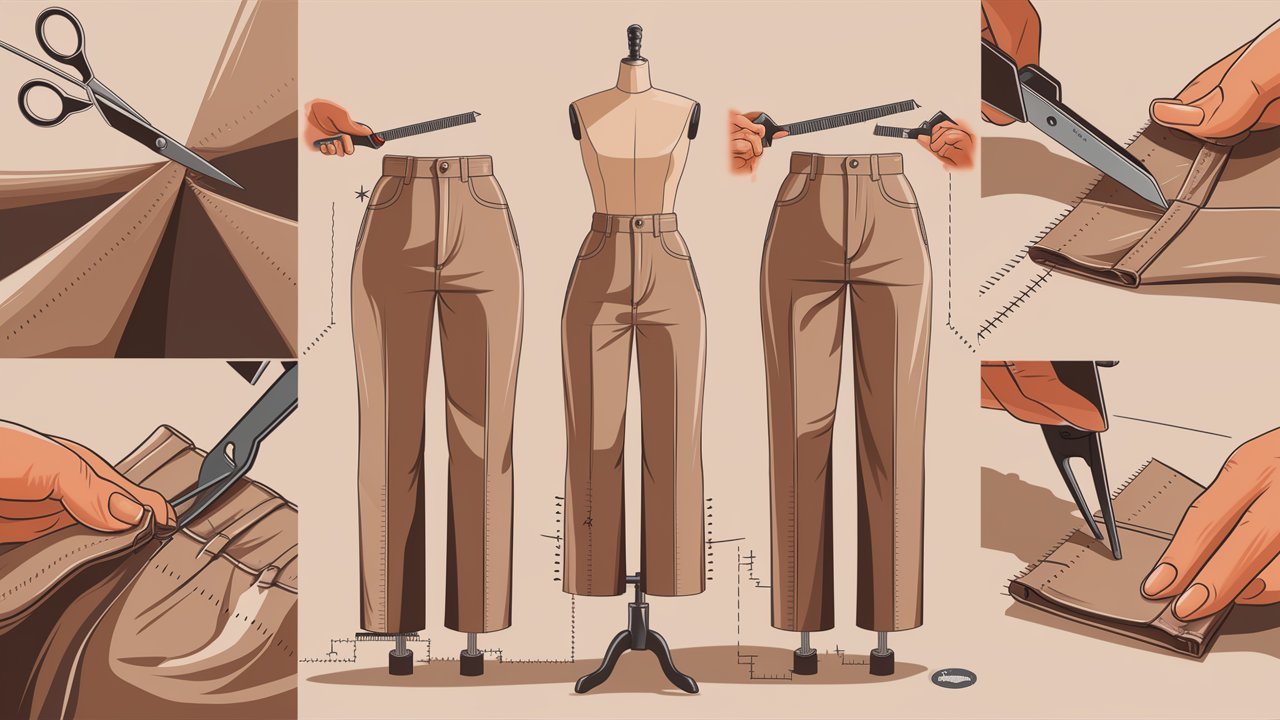Have you ever found the perfect pair of tapered pants that’s just a bit too long? It can be frustrating, especially when you want to avoid paying for expensive alterations. But don’t worry! You can easily learn how to hem tapered pants yourself at home with our expert-backed guide.
Hemming tapered pants can be trickier than hemming regular pants due to the narrower leg opening. However, with the right techniques, you can achieve professional-looking results without damaging the fabric.
In this step-by-step guide, we’ll walk you through the process of hemming tapered pants, ensuring you maintain the perfect fit and style. Our instructions are easy to follow, even if you’re new to sewing.
So, let’s get started and give your favorite tapered pants a new lease on life!
Table of Contents
ToggleKey Takeaways
- Measure hem allowance, mark hemline, and check for accuracy before cutting
- Rip original hem, trim excess fabric, press new hem, and sew slowly for best results
- Avoid common mistakes: measure correctly, don’t cut too much, adjust for taper, iron well, use matching thread
- Troubleshoot issues: fix uneven hems, adjust tension for puckering, add length if too short, use blind hem for thick fabrics
- Practice, take your time, and pay attention to detail for professional-looking results at home
What You’ll Need
Here is a list of necessary materials and tools you will need:
- Tapered pants
- Measuring tape
- Sewing machine
- Thread
- Hemming web or hemming tape
- Scissors
- Iron and ironing board
How to Measure and Mark Your Hem?
Step 1: Measure the Hem Allowance
To start, you’ll need to measure the hem allowance of your tapered pants. The hem allowance is the amount of fabric that you’ll fold up to create the hem. A standard hem allowance is 1.5 inches (3.8 cm), but you can adjust this to your preference.
Take your measuring tape and measure the length of your pants from the bottom of the pant leg to the desired length. Make a note of this measurement.
Step 2: Mark the Hemline
Next, turn your pants inside out and lay them flat on a smooth surface. Fold the raw edge of the pant leg up by the hem allowance you measured in Step 1. Press the fold to create a crisp crease.
Using a ruler or measuring tape, mark the hemline with a pencil or chalk. Make sure to mark the hemline on both pant legs, ensuring they’re even and symmetrical.
Step 3: Check and Adjust
Double-check your measurements and markings to ensure they’re accurate and even. If necessary, make adjustments to the hemline to achieve the desired length.
Tips For Accurate Measurement:
- Use a seam gauge or measuring tape to ensure accurate measurements.
- Pressing the fold will help create a crisp crease and make it easier to mark the hemline.
- If you need more clarification about the hem allowance, start with a smaller allowance and adjust as needed.
By following these steps, you’ll have accurately measured and marked the hem of your tapered pants, setting yourself up for a successful hemming process.
How To Hem Tapered Pants?
Step 1: Rip the Original Hem
Before you can hem tapered pants, you have to remove the original hem. This is important because the original hem might need to be thick or thick enough. Use a seam ripper to carefully remove the stitches. Go slow so you don’t rip the fabric.

Step 2: Measure and Mark the New Hem
Decide how much extra fabric you want for the hem. Most hems are 1/2 inch to 1 inch. Measure this amount from the original hemline and mark it with pins or chalk. Make sure the line is straight all the way around the leg. Measuring from the original hem helps keep the taper of the pants.

Step 3: Trim the Excess Fabric
Cut off the extra fabric below the line you marked. Leave the amount you need for the hem. Be careful to cut in a straight line so the edge isn’t jagged.
Step 4: Press the New Hem
Fold the raw edge of the hem up about 1/4 inch and press it with an iron. Then, fold the hem up to the line you marked and press it again. Pressing helps make a neat, crisp hem.
Step 5: Sew the New Hem
Use a sewing machine to sew the new hem. You can use a straight stitch or a blind hem stitch. Sew slowly and keep the stitching line straight and close to the folded edge. At the start and end of the seam, backstitch to make the stitches strong.

Sep 6: Press and Finish
Press the pants one last time to make them look really nice. Try them on to check that the hem is even and the length is just right. If you need to, you can make small changes now. And that’s it! You’ve hemmed your tapered pants.
Common Mistakes To Avoid When Hemming Tapered Pants
Hemming tapered pants can be tricky, but with a little know-how, you can achieve professional-looking results at home. However, there are some common mistakes that many people make when hemming tapered pants.
Here are a few pitfalls to watch out for:
1) Not Measuring Correctly
One of the most common mistakes is to measure the hem correctly. Make sure to measure from the floor to where you want the hem to fall while wearing the shoes you plan to wear with the pants. Also, measure both legs to ensure they are even. Uneven hems can ruin the look of your tapered pants.
2) Cutting Off Too Much Fabric
When trimming the excess fabric, be conservative. You can always cut more if needed, but you can’t add fabric back once it’s cut off. Leave about an inch of extra fabric to allow for any errors or future alterations.
3) Not Adjusting for the Taper
Tapered pants get narrower from the knee down to the ankle. When hemming, you need to gradually take in the side seams near the hem to maintain that tapered look. If you fold and sew a straight hem, you’ll end up with a wide, sloppy-looking hem that flares out at the bottom.
4) Skipping the Iron
Ironing is crucial for a clean, professional hem. Before sewing, press the hem fold to create a crisp crease. After sewing, press the finished hem flat. Skipping this step can leave your hem looking puckered and messy.
5) Using the Wrong Thread
Choose a thread color that closely matches your pants. If the thread is too contrasting, it will be visible on the outside of the hem and look sloppy. When in doubt, go a shade darker rather than lighter.
6) Not Trying Them On
Always try on your newly hemmed pants before finishing the hem. Pin the hem in place, put on your shoes, and check the length in a mirror. Make any necessary adjustments before sewing the hem permanently.
By avoiding these common hemming mistakes, you’ll be able to achieve a clean, professional-looking hem on your tapered pants.
Troubleshooting Common Issues During the Hemming Process
Even if you follow all the steps carefully, you might run into some issues when hemming your tapered pants. Don’t worry, though! These problems are common and can be easily fixed. Here are some troubleshooting tips for the most common issues:
1) The Hem is Uneven
If you notice that the hem is uneven after sewing, don’t panic. This is a common issue and can be fixed. First, try on the pants and mark the uneven spots with pins. Then, remove the hem stitches in the uneven area and re-sew the hem, making sure to keep the hemline straight.
2) The Fabric is Puckering
Puckering can happen when the tension on your sewing machine is too tight. To fix this, adjust the tension on your machine and try sewing a test scrap of fabric. If the puckering persists, try using a walking foot or a stabilizer to help feed the fabric evenly through the machine.
3) The Hem is Too Short
If you’ve accidentally cut off too much fabric or the hem is just too short for your liking, there are a few ways to fix it. One option is to add a decorative cuff or trim to the bottom of the pants to add length. Another option is to let out the existing hem and re-sew it at a longer length.
4) The Hem is Too Thick
If the hem feels too thick or bulky, especially with heavier fabrics like denim, you can try a few different techniques. One option is to use a blind hem stitch, which will create a less visible and less bulky hem. Another option is to trim the seam allowance down to 1/4 inch before folding and sewing the hem.
5) The Fabric is Fraying
If the fabric is fraying at the cut edge of the hem, you can use a few different techniques to prevent further fraying. One option is to use pinking shears to cut the edge in a zigzag pattern, which will help prevent fraying. Another option is to use a fray-preventing product like Fray Check or clear nail polish on the cut edge before folding and sewing the hem.
Remember, even the most experienced sewers run into issues sometimes. The key is to stay calm and take your time.
This Video Might Help!
Final Thoughts
Learning how to hem tapered pants is a valuable skill that can save you time and money. With a little practice and patience, you can achieve professional-looking results at home.
Remember to take accurate measurements, avoid common mistakes, and troubleshoot any issues that arise. Whether you’re hemming a pair of jeans or dress pants, the key is to take your time and pay attention to detail.
With this step-by-step guide, you’ll be able to confidently hem your tapered pants and enjoy a perfect fit every time. So go ahead and give it a try – you’ve got this!


